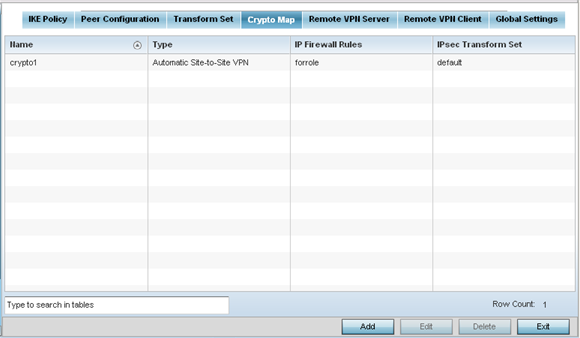Use crypto maps (as applied to IPSec VPN) to combine the elements used to create IPSec SAs (including transform sets).
To define a profile's VPN settings:
Select the Configuration tab from the Web UI.
Select Profiles from the Configuration tab.
Select Manage Profiles from the Configuration > Profiles menu.
Select Security.
Select VPN.
Select the Crypto Map tab.
Use Crypto Maps (as applied to IPSec VPN) to combine the elements used to create IPSec SAs (including transform sets).

Review the following Crypto Map configuration parameters to assess their relevance:
|
Name |
Lists the 32 character maximum name assigned for each crypto map upon creation. This name cannot be modified as part of the edit process. |
|
Type |
Displays the site-to-site-manual, site-to-site-auto or remote VPN configuration defined for each listed cyrpto map configuration. With site-to-site deployments, an IPSEC Tunnel is deployed between two gateways, each at the edge of two different remote networks. With remote VPN, an access point (located remotely) defines a tunnel with a security gateway. This facilitates the endpoints in the branch office to communicate with the destination endpoints (behind the security gateway) in a secure manner. |
|
IP Firewall Rules |
Lists the IP firewall rules defined for each displayed crypto map configuration. Each firewall policy contains a unique set of access/deny permissions applied to the VPN tunnel and its peer connection. |
|
IPSec Transform Set |
Displays the transform set (encryption and has algorithms) applied to each listed crypto map configuration. Thus, each crypto map can be customized with its own data protection and peer authentication schemes. |
If requiring a new crypto map configuration, select the Add button. If updating the configuration of an existing crypto map, select it from amongst those available and select the Edit button.